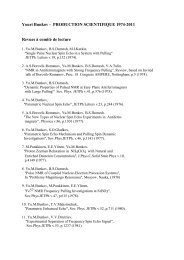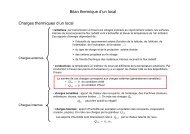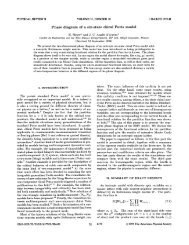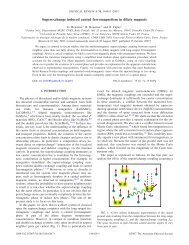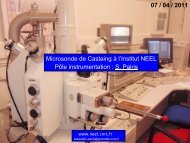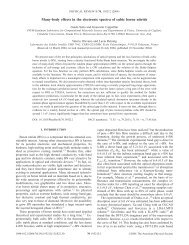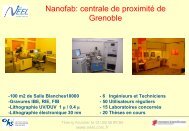Activity Report 2010 - CNRS
Activity Report 2010 - CNRS
Activity Report 2010 - CNRS
You also want an ePaper? Increase the reach of your titles
YUMPU automatically turns print PDFs into web optimized ePapers that Google loves.
DETECTING SINGLE<br />
NANOPARTICLE<br />
MAGNETIZATION<br />
REVERSAL WITH A<br />
NANOTUBE<br />
Nanospintronics benefits from advances<br />
in quantum transport and molecular<br />
electronics. Combining these concepts<br />
provides new devices highly sensitive to<br />
the local electromagnetic environment<br />
such as carbon nanotube quantum dots.<br />
Moreover molecular objects offer great<br />
versatility in their functionnalization with<br />
magnetic systems such as nanoparticles<br />
or molecular magnets, offering new<br />
routes towards nanoscale spin detection.<br />
Magneto-Coulomb effect in<br />
nanotube quantum dots<br />
filled with magnetic<br />
nanoparticles<br />
“Fil de l’eau” PhD student 2007:<br />
Subhadeep DATTA<br />
Carbon nanotubes at low temperature<br />
behave as quantum dots (QD) for which<br />
charging processes become quantized,<br />
giving rise to Coulomb blockade. Any<br />
small change in the electrostatic<br />
environment (tuned by the gate<br />
electrode, see Fig. 1, top) can induce a<br />
shift of the energy of the QD, leading to<br />
conductivity variation. A carbon nanotube<br />
can therefore be a very accurate<br />
electrometer. If a magnetic system is<br />
electronically coupled to a nanotube, its<br />
spin state can influence sequential<br />
tunneling through the nanotube (socalled<br />
magneto-Coulomb effect).<br />
The context in which the magneto-<br />
Coulomb effect (MCE) was first observed<br />
was that of single-electron transistors<br />
connected with two ferromagnetic leads.<br />
This effect was characterized by an<br />
enhanced magnetoresistance (MR) of the<br />
island in the Coulomb blockade regime.<br />
This feature originated from the Zeeman<br />
energy of the ferromagnetic contacts,<br />
inducing a shift between the majority and<br />
minority spin energy bands. It resulted in<br />
a modification of the island chemical<br />
potential, which is equivalent to effective<br />
electrostatic gating. The MCE thus<br />
enabled the single electron transistor to<br />
be driven by the magnetic field.<br />
In our case, the hollow center of a double<br />
wall carbon nanotube is filled with<br />
magnetic nanoparticles such as iron<br />
(collaboration with Institut Carnot<br />
CIRIMAT, University of Toulouse). We<br />
observe unprecedented high MR reaching<br />
up to 53% at 40 mK with a hysteretic<br />
behaviour and sharp jumps at specific<br />
magnetic fields corresponding to the<br />
magnetization reversal of the<br />
encapsulated particle (see Fig. 1,<br />
bottom). Moreover these features are<br />
strongly gate dependent and reflect<br />
directly the features from Coulomb<br />
blockade in the QD. Indeed, the spin flip<br />
of the iron island at non-zero magnetic<br />
field causes a sharp change in the<br />
nanoparticle chemical potential due to<br />
the Zeeman energy, which is acting on<br />
the nanotube like an effective offset<br />
charge. Such coupling allows the<br />
detection of a single reversal event, with<br />
high accuracy considering its strong<br />
influence on the magnetoresistance.<br />
This effect is thus a new gate dependent<br />
MR, which differs from that described in<br />
previous reports in which the MCE<br />
originated from the contact between<br />
nanostructures and ferromagnetic leads.<br />
Here the MCE is induced by the local<br />
coupling of a nanotube quantum dot with<br />
low-dimensional magnets. This coupling<br />
allows differentiating the sensor from the<br />
probed magnetic object. It opens up new<br />
possibilities for exploiting the versatility<br />
of nanotube QD functionnalization with<br />
different nanomagnets, using double wall<br />
nanotube (DWNTs) filled with various<br />
materials, functionalized on their surface<br />
with molecular magnets.<br />
Fig. 1: Top: transistor based on a double wall<br />
carbon nanotube, the inner tube of which is<br />
filled with magnetic iron nanomagnet; Bottom:<br />
strong resistance variations R and strong MR<br />
hysteresis observed for different applied gate<br />
voltages Vg. Quantum transport and<br />
magnetization reversal are directly correlated<br />
and appear as color changes.<br />
CONTACTS<br />
4<br />
HIGHLIGHT : NANOMAGNETISM AND SPINTRONICS<br />
laetitia.marty@grenoble.cnrs.fr<br />
wolfgang.wernsdorfer@grenoble.cnrs.fr<br />
FURTHER READING<br />
L. Bogani et al., Nature Mater. 7, p179,<br />
(2008)



